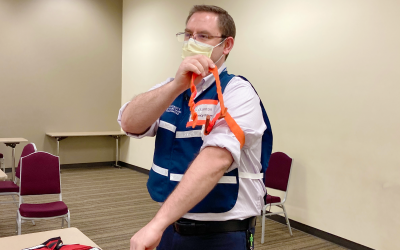UMB Employee, Stop the Bleed Save Gunshot Victim
March 26, 2021 Charles Schelle
Through Stop the Bleed training, anyone can learn how to save a life the way UMB’s Christopher Stanton did.
When Christopher Stanton, MS, talks about how he stopped a man from bleeding to death from a gunshot wound and a fractured tibia on March 15, it comes out so matter-of-factly that you get the sense he’s done this before.
That’s because as a volunteer emergency medical technician (EMT) for Laurel Volunteer Fire Department since 2001, he has.
“Very quickly I go from holding my 2-year-old’s hands to cutting off the pants of this guy and putting on the torniquet. It was all based on training,” said the deputy director of the University of Maryland, Baltimore (UMB) Office of Emergency Management, who is also helping to oversee the UMB COVID-19 vaccination clinic.
Rewinding back two Mondays ago, Stanton was with his wife and 2 1/2-year-old son at the University of Maryland Medical Center (UMMC) for his son’s routine checkup. When they were about to exit the lobby on Greene Street, a woman entered shouting that a man who had been shot was pushed out of a car and bleeding on the sidewalk.
Stanton didn’t hesitate to help, with his training kicking in immediately. He didn’t have a dispatch call and an ambulance ride to help buy time to visualize a plan.
“In this case, I didn’t expect to be helping somebody,” he said.
The scissors, tourniquet, gloves, bandages, and blood weren’t just handed to him by medical staff on standby. He was able to quickly save the man’s life because he knew UMMC and UMB have Stop the Bleed kits throughout their buildings.
The kits are part of the national Stop the Bleed campaign, designed to teach basic skills to stop preventable bleeding deaths.
You don’t have to be an EMT or a medical professional to learn how to save someone’s life using a Stop the Bleed kit.
Training classes had been offered before the pandemic through UMMC since 2017, and are expected to resume once the pandemic is under control. During a course, participants spend about 90 minutes learning and practicing techniques to apply direct pressure, pack a wound, and use a tourniquet to stop bleeding.